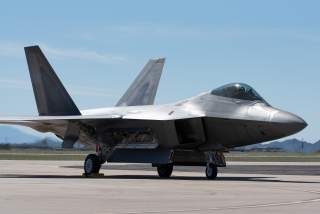This Isn't a Secret: F-22 Raptor Stealth Fighters Aren't Exactly Invisible
And China might be able to track them.
Is this really a problem?
State-run Chinese media is claiming that the People’s Liberation Army has been able to track the U.S. Air Force’s Lockheed Martin F-22 Raptor stealth fighters over the East China Sea. While the Chinese report might be easily dismissed as propaganda—it is not beyond the realm of possibility. In fact—it’s very possible that China can track the Raptor. Stealth is not a cloak of invisibility, after all. Stealth technology simply delays detection and tracking.
(This first appeared in 2016.)
First off, if a Raptor is carrying external fuel tanks—as it often does during “ferry missions”—it is not in a stealth configuration. Moreover, the aircraft is often fitted with a Luneburg lens device on its ventral side during peacetime operations that enhances its cross section on radar.
That being said, even combat-configured F-22s are not invisible to enemy radar, contrary to popular belief. Neither is any other tactical fighter-sized stealth aircraft with empennage surfaces such as tailfins—the F-35, PAK-FA, J-20 or J-31. That’s just basic physics.
The laws of physics essentially dictate that a tactical fighter-sized stealth aircraft must be optimized to defeat higher-frequency bands such the C, X, Ku and the top part of the S bands. There is a “step change” in a Low Observable (LO) aircraft’s signature once the frequency wavelength exceeds a certain threshold and causes a resonant effect. Typically, that resonance occurs when a feature on an aircraft—such as a tail-fin — is less than eight times the size of a particular frequency wavelength. Effectively, small stealth aircraft that do not have the size or weight allowances for two feet or more of radar absorbent material coatings on every surface are forced to make trades as to which frequency bands they are optimized for.
Therefore, a radar operating at a lower-frequency band such as parts of the S or L band—like civilian air traffic control (ATC) radars—are almost certainly able to detect and track tactical fighter-sized stealth aircraft. However, a larger stealth aircraft like the Northrop Grumman B-2 Spirit, which lacks many of the features that cause a resonance effect, is much more effective against low-frequency radars than, for example, an F-35 or F-22. Typically, however, those lower-frequency radars do not provide what Pentagon officials call a “weapons quality” track needed to guide a missile onto a target. “Even if you can see an LO [low observable] strike aircraft with ATC radar, you can’t kill it without a fire control system,” an Air Force official had told me.
That being said, Russia, China and others are developing advanced UHF and VHF band early warning radars that use even longer wavelengths in an effort to cue their other sensors and give their fighters some idea of where an adversary stealth aircraft might be coming from. But the problem with VHF and UHF band radars is that with long wavelengths come large radar resolution cells. That means that contacts are not tracked with the required level of fidelity to guide a weapon onto a target. As one U.S. Navy officer rhetorically asked, “Does the mission require a cloaking device or is it OK if the threat sees it but can’t do anything about it?”
Traditionally, guiding weapons with low frequency radars has been limited by two factors. One factor is the width of the radar beam, while the second is the width of the radar pulse—but both limitations can be overcome with signal processing. Phased array radars—particularly active electronically scanned arrays (AESA)—solve the problem of directional or azimuth resolution because they can steer their radar beams electronically. Moreover, AESA radars can generate multiple beams and can shape those beams for width, sweep rate and other characteristics. Indeed, some industry experts suggested that a combination of high-speed data-links and low-frequency phased-array radars could generate a weapons quality track.
The U.S. Navy and Lockheed may have already solved the problem. The service openly talks about the E-2D’s role as the central node of its NIFC-CA battle network to defeat enemy air and missile threats. Rear Adm. Mike Manazir, the Navy’s director of air warfare, described the concept in detail at the U.S. Naval Institute just before Christmas in 2013.
Under the NIFC-CA ‘From the Air’ (FTA) construct, the APY-9 radar would act as a sensor to cue Raytheon AIM-120 AMRAAM air-to-air missiles for Boeing F/A-18E/F Super Hornets fighters via the Link-16 datalink. Moreover, the APY-9 would also act as a sensor to guide Raytheon Standard SM-6 missiles launched from Aegis cruisers and destroyers against targets located beyond the ships’ SPY-1 radars’ horizon via the Cooperative Engagement Capability datalink under the NIFC-CA ‘From the Sea’ (FTS) construct. In fact, the Navy has demonstrated live-fire NIFC-CA missile shots using the E-2D’s radar to guide SM-6 missiles against over-the-horizon shots—which by definition means the APY-9 is generating a weapons quality track.
That effectively means that stealthy tactical aircraft must operate alongside electronic attack platforms the like Boeing EA-18G Growler. It is also why the Pentagon has been shoring up American investments in electronic and cyber warfare. As one Air Force official explained, stealth and electronic attack always have a synergistic relationship because detection is about the signal-to-noise ratio. Low observables reduce the signal, while electronic attack increases the noise. “Any big picture plan, looking forward, to deal with emerging A2/AD threats will address both sides of that equation,” he said.
Dave Majumdar is the former defense editor for the National Interest.

